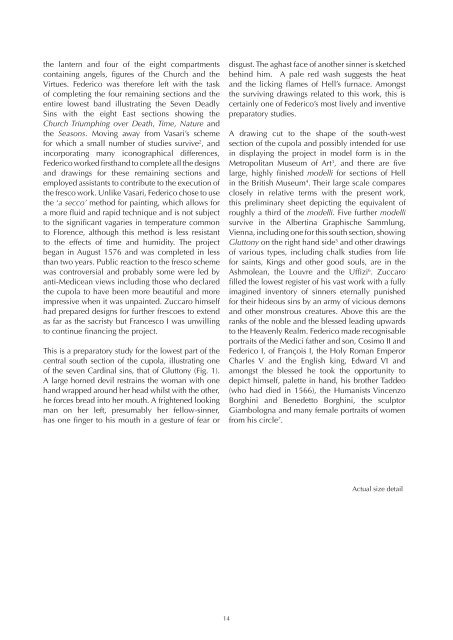Works on Paper 2019 - Jean Luc Baroni
- No tags were found...
You also want an ePaper? Increase the reach of your titles
YUMPU automatically turns print PDFs into web optimized ePapers that Google loves.
the lantern and four of the eight compartments<br />
c<strong>on</strong>taining angels, figures of the Church and the<br />
Virtues. Federico was therefore left with the task<br />
of completing the four remaining secti<strong>on</strong>s and the<br />
entire lowest band illustrating the Seven Deadly<br />
Sins with the eight East secti<strong>on</strong>s showing the<br />
Church Triumphing over Death, Time, Nature and<br />
the Seas<strong>on</strong>s. Moving away from Vasari’s scheme<br />
for which a small number of studies survive 2 , and<br />
incorporating many ic<strong>on</strong>ographical differences,<br />
Federico worked firsthand to complete all the designs<br />
and drawings for these remaining secti<strong>on</strong>s and<br />
employed assistants to c<strong>on</strong>tribute to the executi<strong>on</strong> of<br />
the fresco work. Unlike Vasari, Federico chose to use<br />
the ‘a secco’ method for painting, which allows for<br />
a more fluid and rapid technique and is not subject<br />
to the significant vagaries in temperature comm<strong>on</strong><br />
to Florence, although this method is less resistant<br />
to the effects of time and humidity. The project<br />
began in August 1576 and was completed in less<br />
than two years. Public reacti<strong>on</strong> to the fresco scheme<br />
was c<strong>on</strong>troversial and probably some were led by<br />
anti-Medicean views including those who declared<br />
the cupola to have been more beautiful and more<br />
impressive when it was unpainted. Zuccaro himself<br />
had prepared designs for further frescoes to extend<br />
as far as the sacristy but Francesco I was unwilling<br />
to c<strong>on</strong>tinue financing the project.<br />
This is a preparatory study for the lowest part of the<br />
central south secti<strong>on</strong> of the cupola, illustrating <strong>on</strong>e<br />
of the seven Cardinal sins, that of Glutt<strong>on</strong>y (Fig. 1).<br />
A large horned devil restrains the woman with <strong>on</strong>e<br />
hand wrapped around her head whilst with the other,<br />
he forces bread into her mouth. A frightened looking<br />
man <strong>on</strong> her left, presumably her fellow-sinner,<br />
has <strong>on</strong>e finger to his mouth in a gesture of fear or<br />
disgust. The aghast face of another sinner is sketched<br />
behind him. A pale red wash suggests the heat<br />
and the licking flames of Hell’s furnace. Am<strong>on</strong>gst<br />
the surviving drawings related to this work, this is<br />
certainly <strong>on</strong>e of Federico’s most lively and inventive<br />
preparatory studies.<br />
A drawing cut to the shape of the south-west<br />
secti<strong>on</strong> of the cupola and possibly intended for use<br />
in displaying the project in model form is in the<br />
Metropolitan Museum of Art 3 , and there are five<br />
large, highly finished modelli for secti<strong>on</strong>s of Hell<br />
in the British Museum 4 . Their large scale compares<br />
closely in relative terms with the present work,<br />
this preliminary sheet depicting the equivalent of<br />
roughly a third of the modelli. Five further modelli<br />
survive in the Albertina Graphische Sammlung,<br />
Vienna, including <strong>on</strong>e for this south secti<strong>on</strong>, showing<br />
Glutt<strong>on</strong>y <strong>on</strong> the right hand side 5 and other drawings<br />
of various types, including chalk studies from life<br />
for saints, Kings and other good souls, are in the<br />
Ashmolean, the Louvre and the Uffizi 6 . Zuccaro<br />
filled the lowest register of his vast work with a fully<br />
imagined inventory of sinners eternally punished<br />
for their hideous sins by an army of vicious dem<strong>on</strong>s<br />
and other m<strong>on</strong>strous creatures. Above this are the<br />
ranks of the noble and the blessed leading upwards<br />
to the Heavenly Realm. Federico made recognisable<br />
portraits of the Medici father and s<strong>on</strong>, Cosimo II and<br />
Federico I, of François I, the Holy Roman Emperor<br />
Charles V and the English king, Edward VI and<br />
am<strong>on</strong>gst the blessed he took the opportunity to<br />
depict himself, palette in hand, his brother Taddeo<br />
(who had died in 1566), the Humanists Vincenzo<br />
Borghini and Benedetto Borghini, the sculptor<br />
Giambologna and many female portraits of women<br />
from his circle 7 .<br />
Actual size detail<br />
14
















